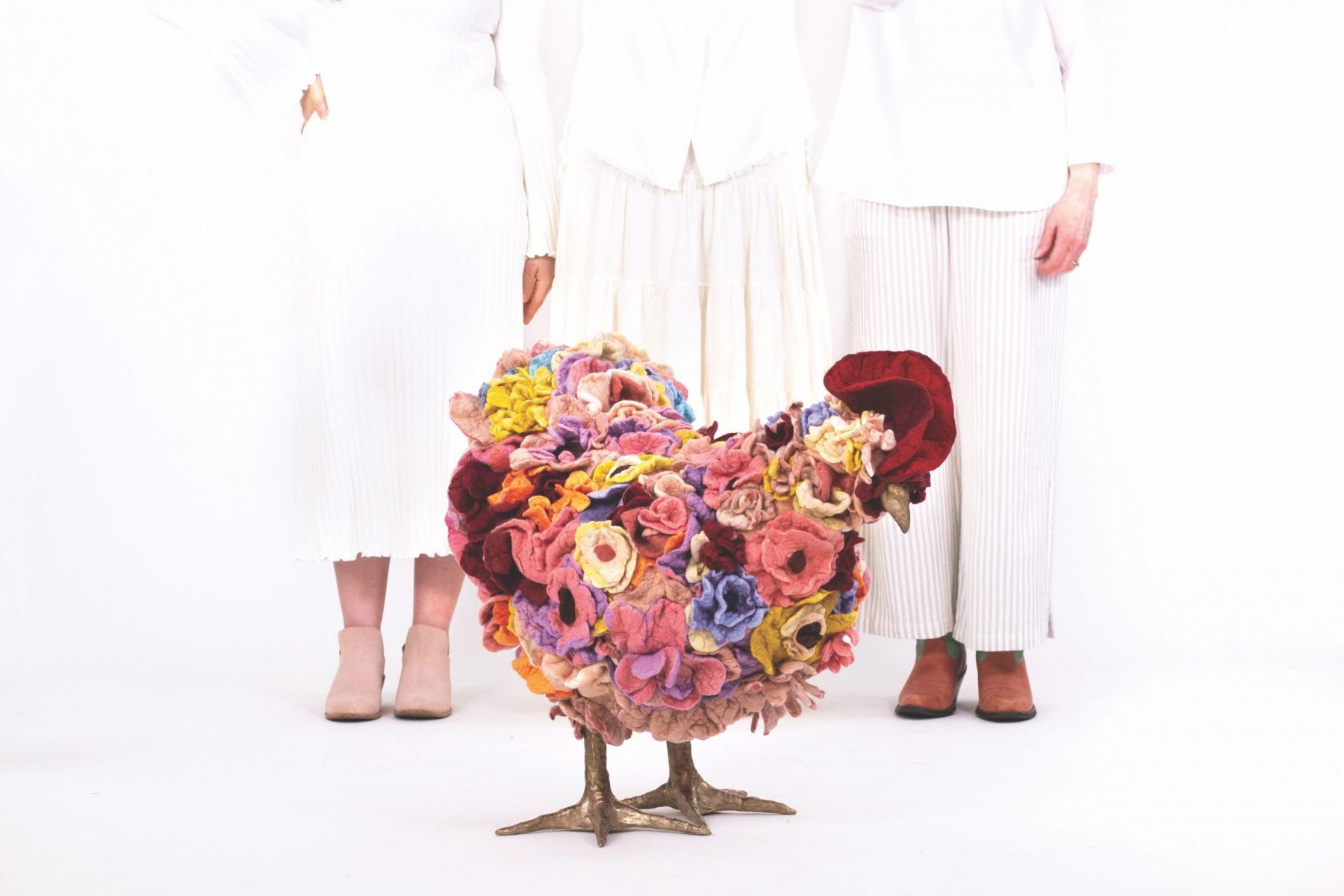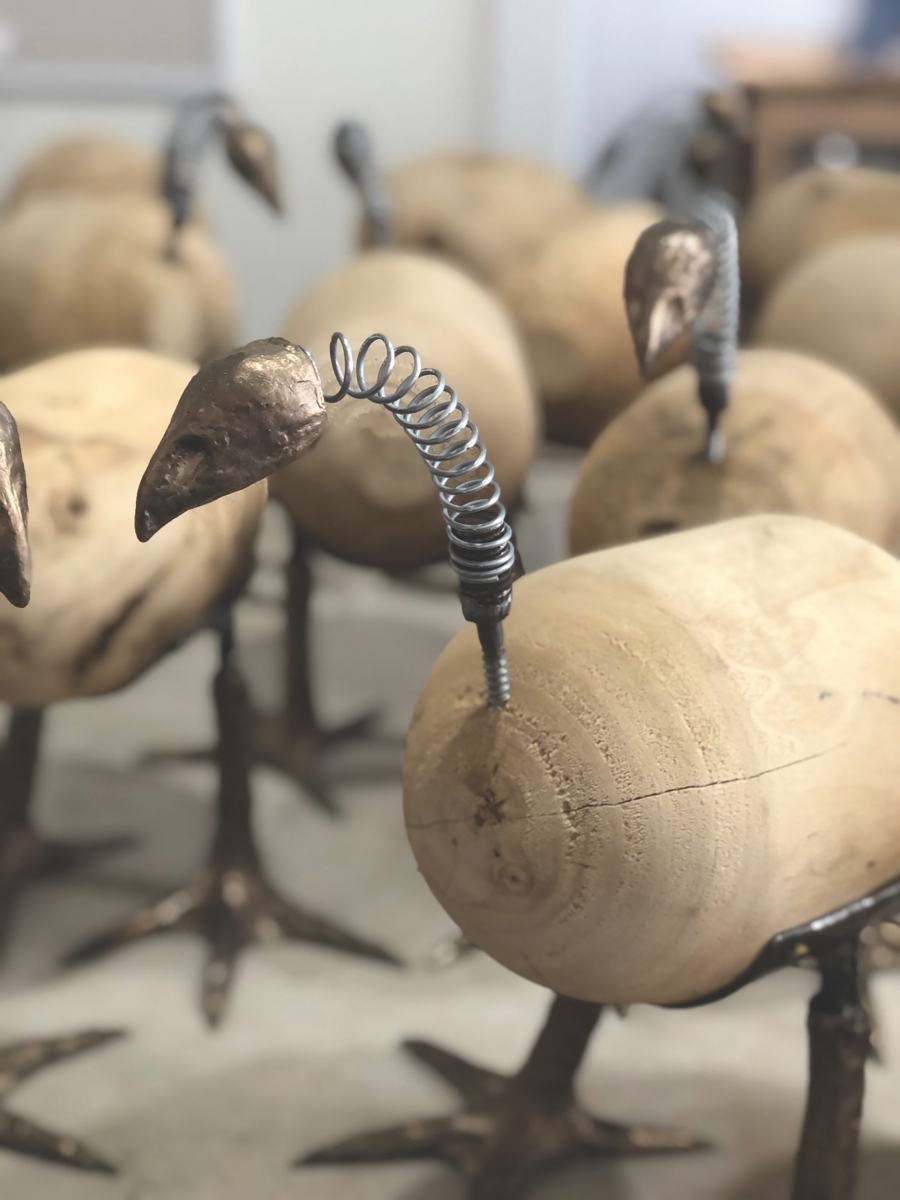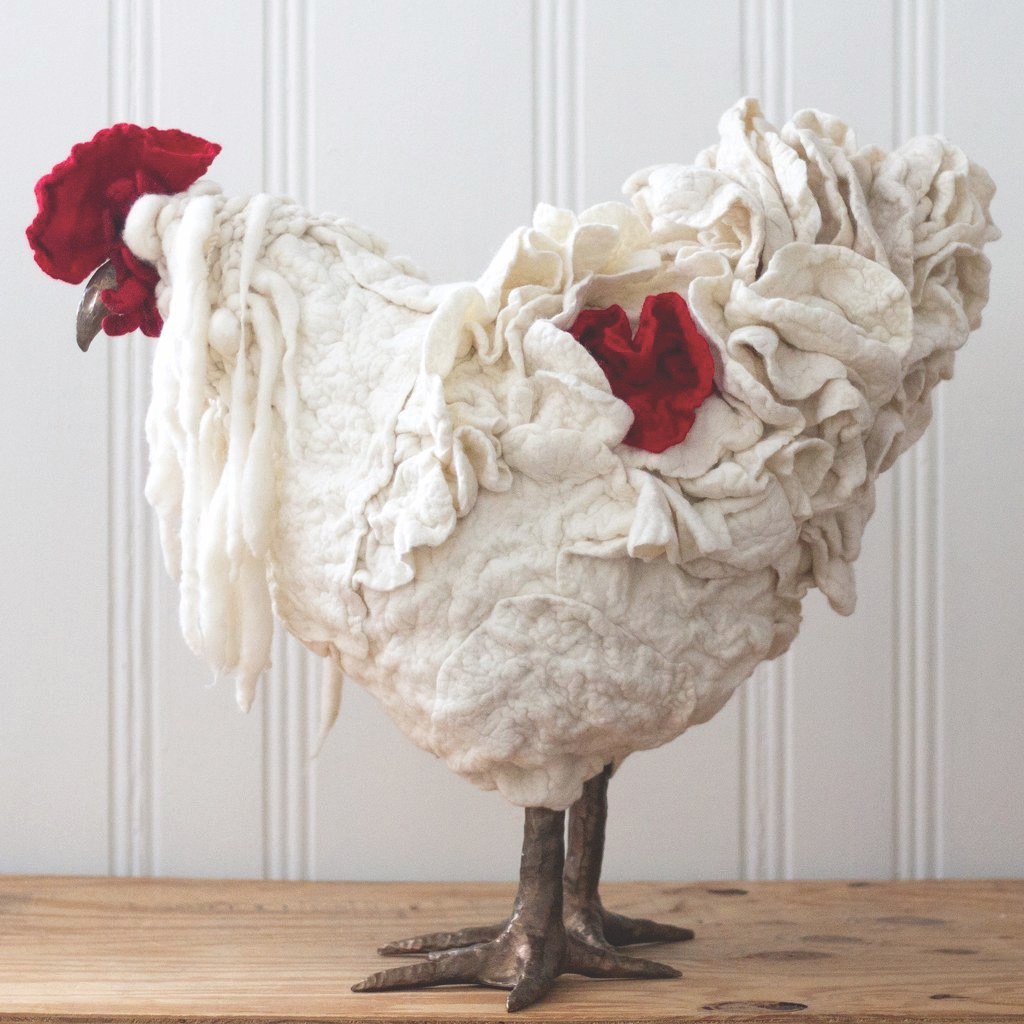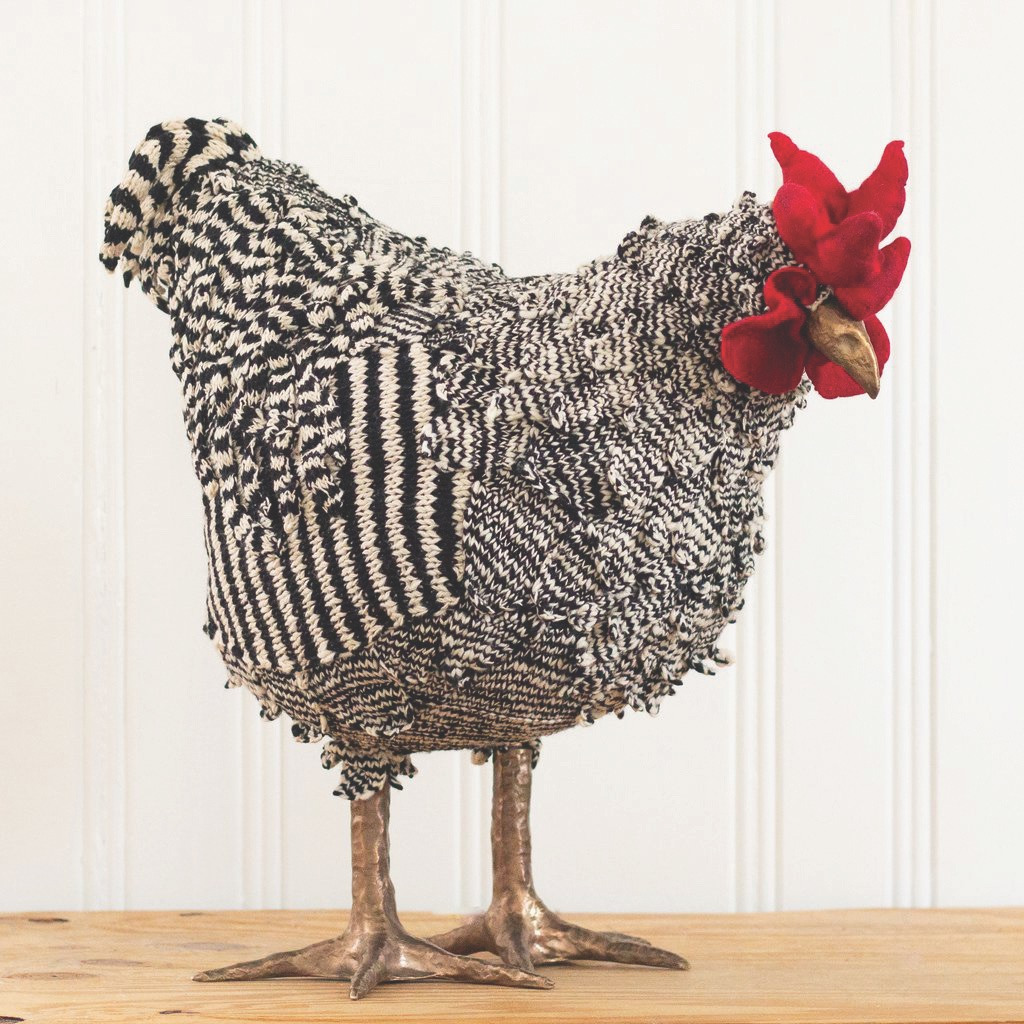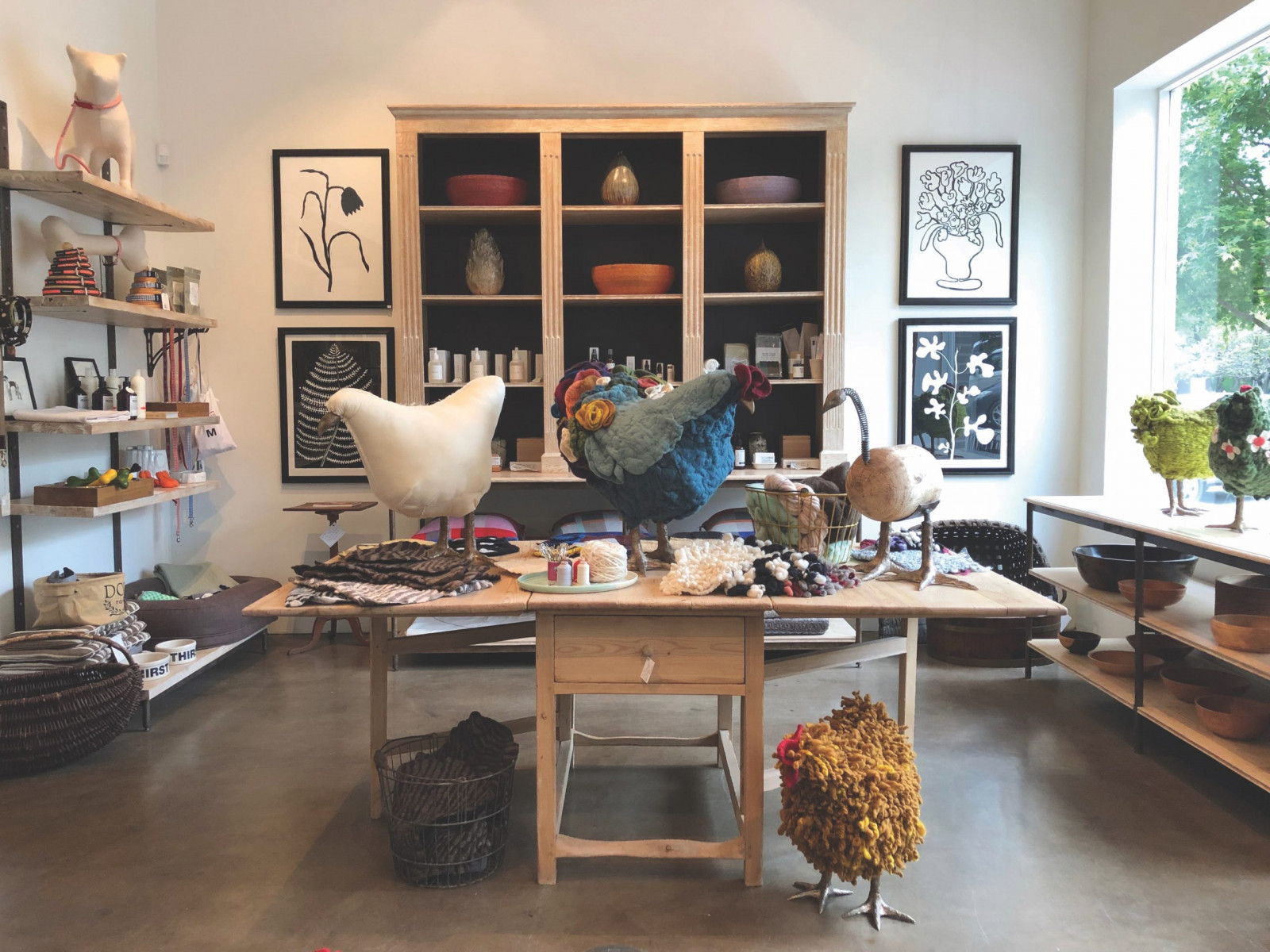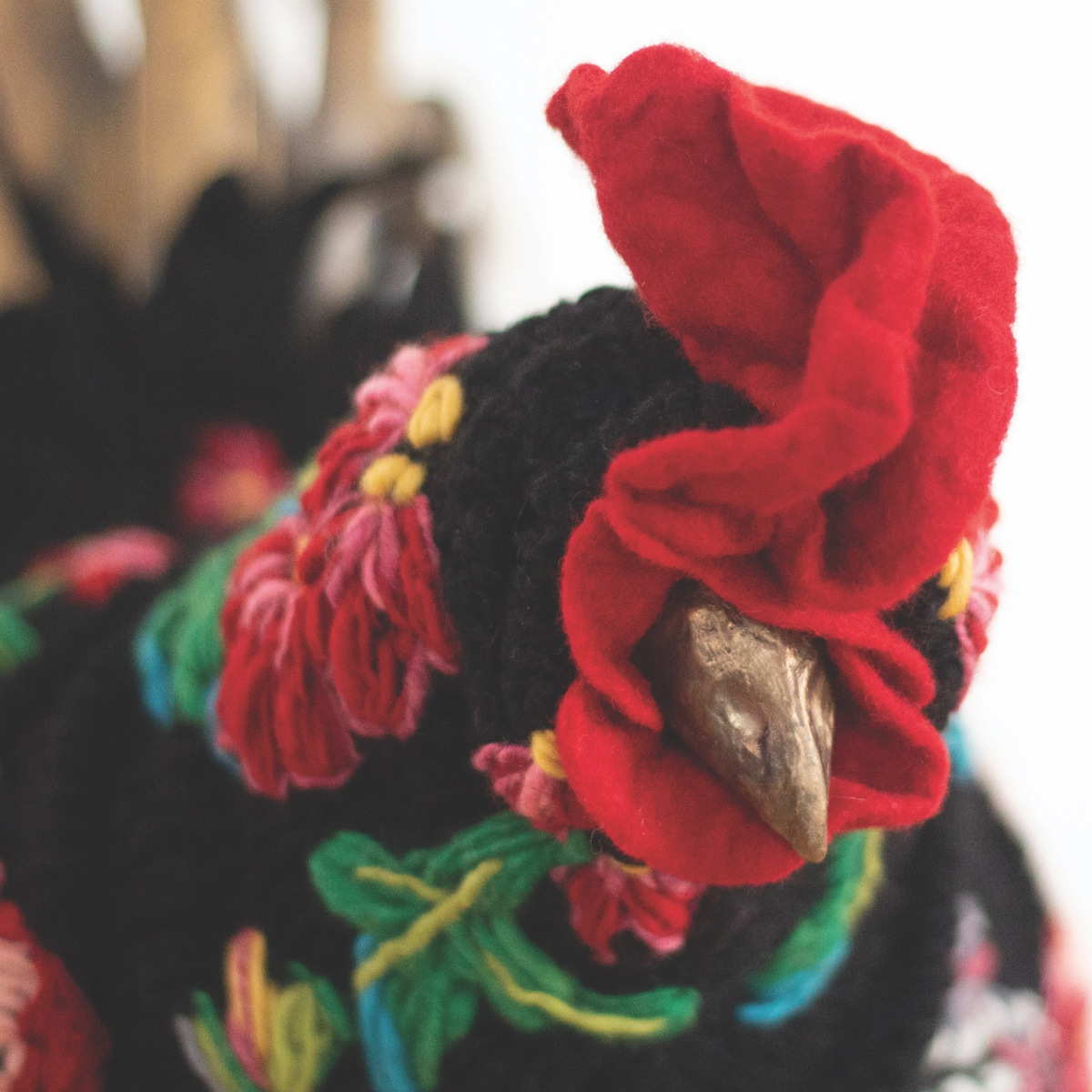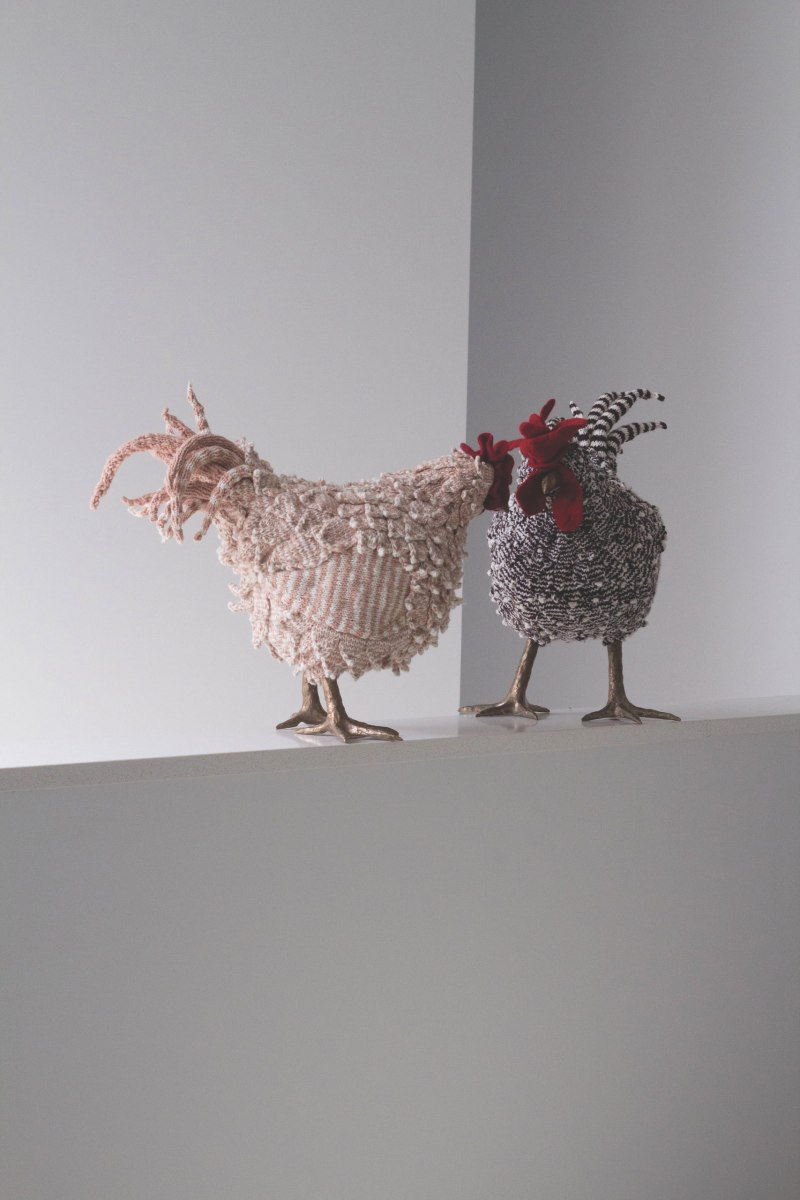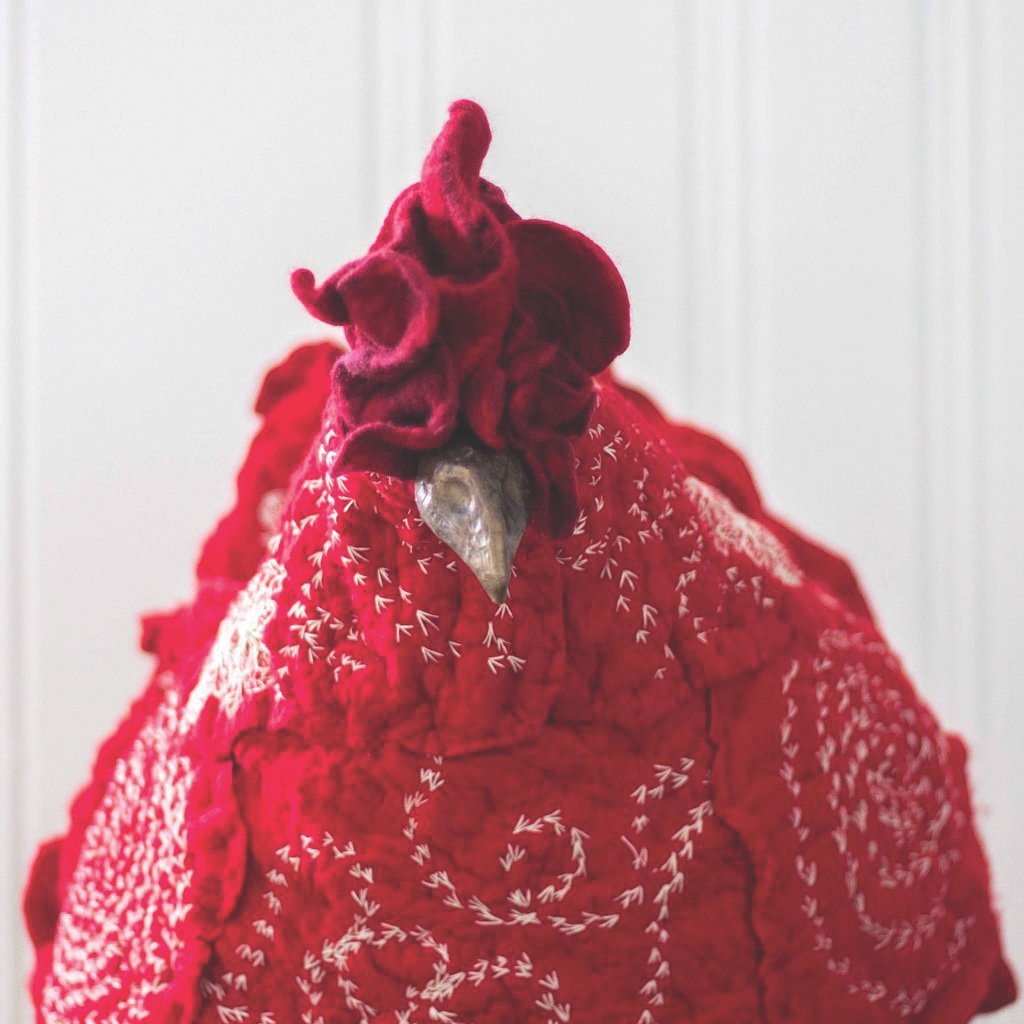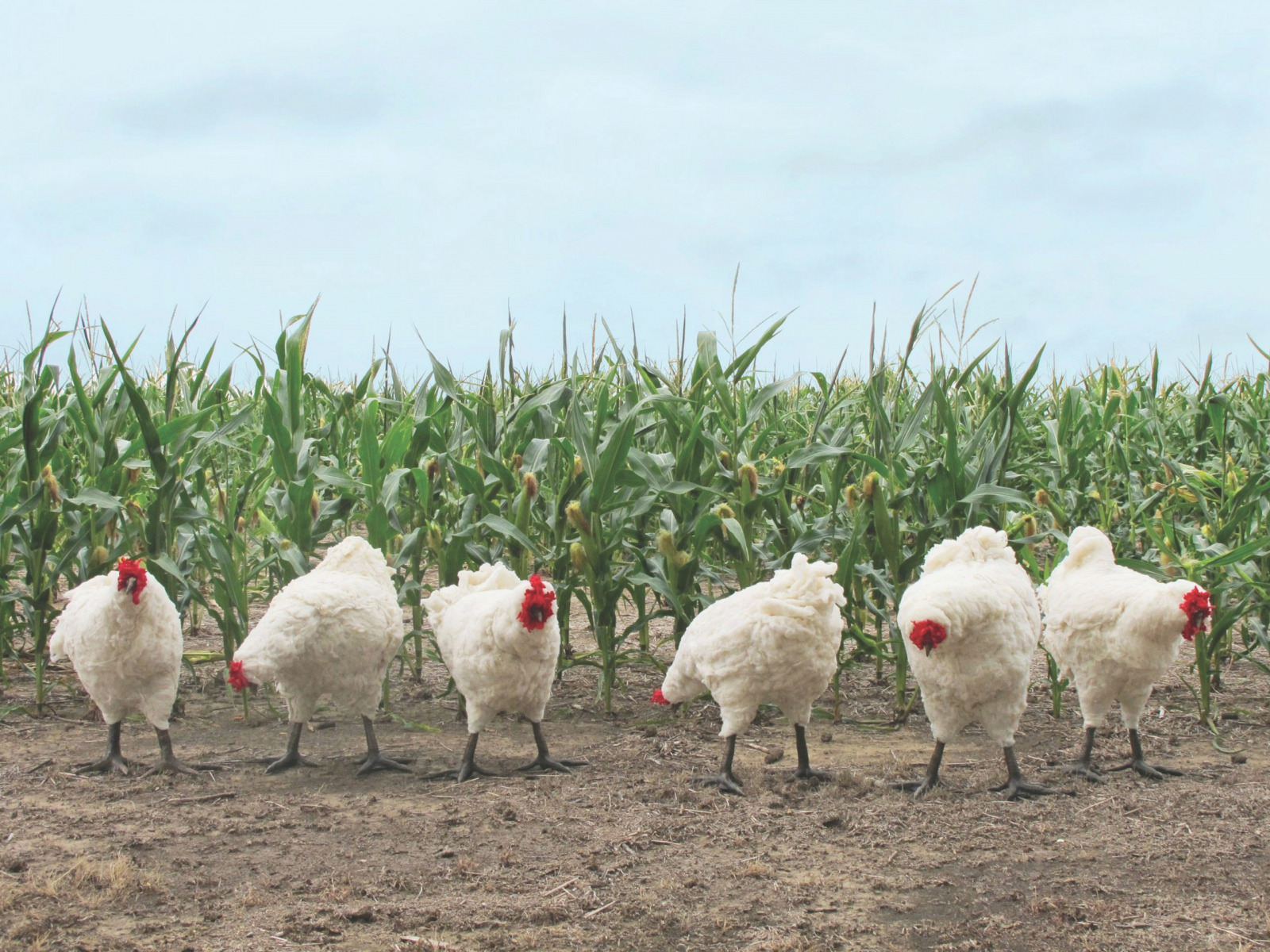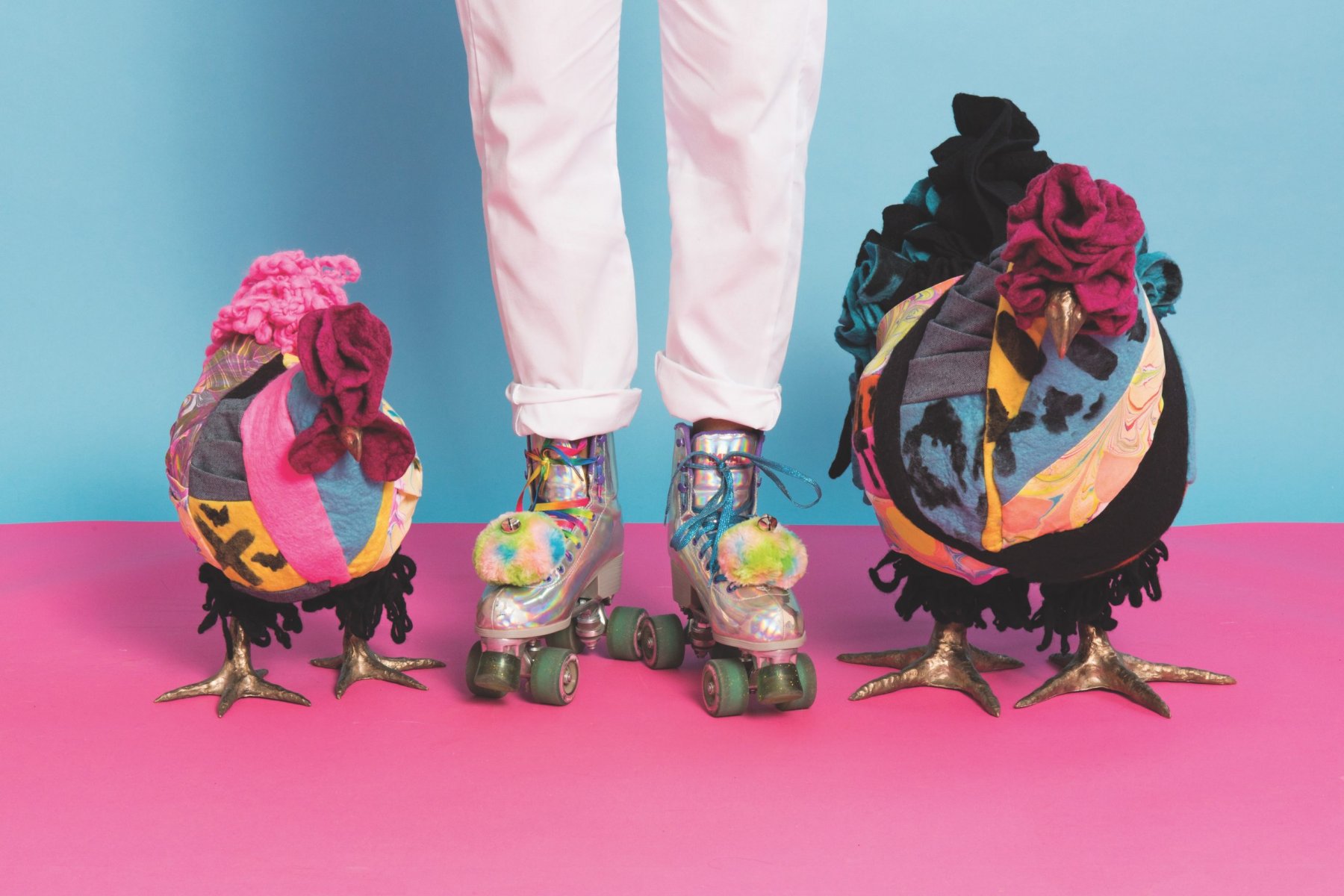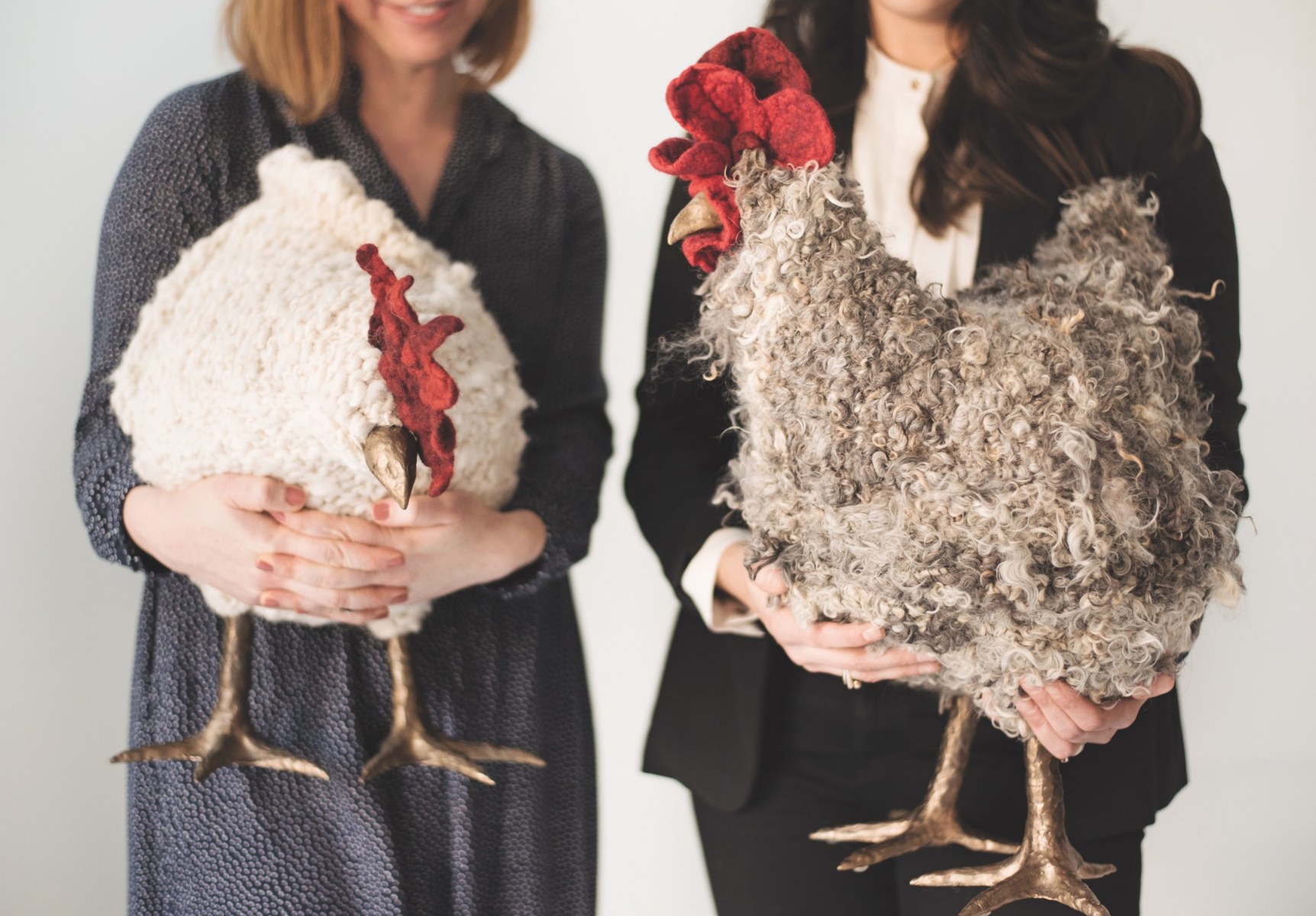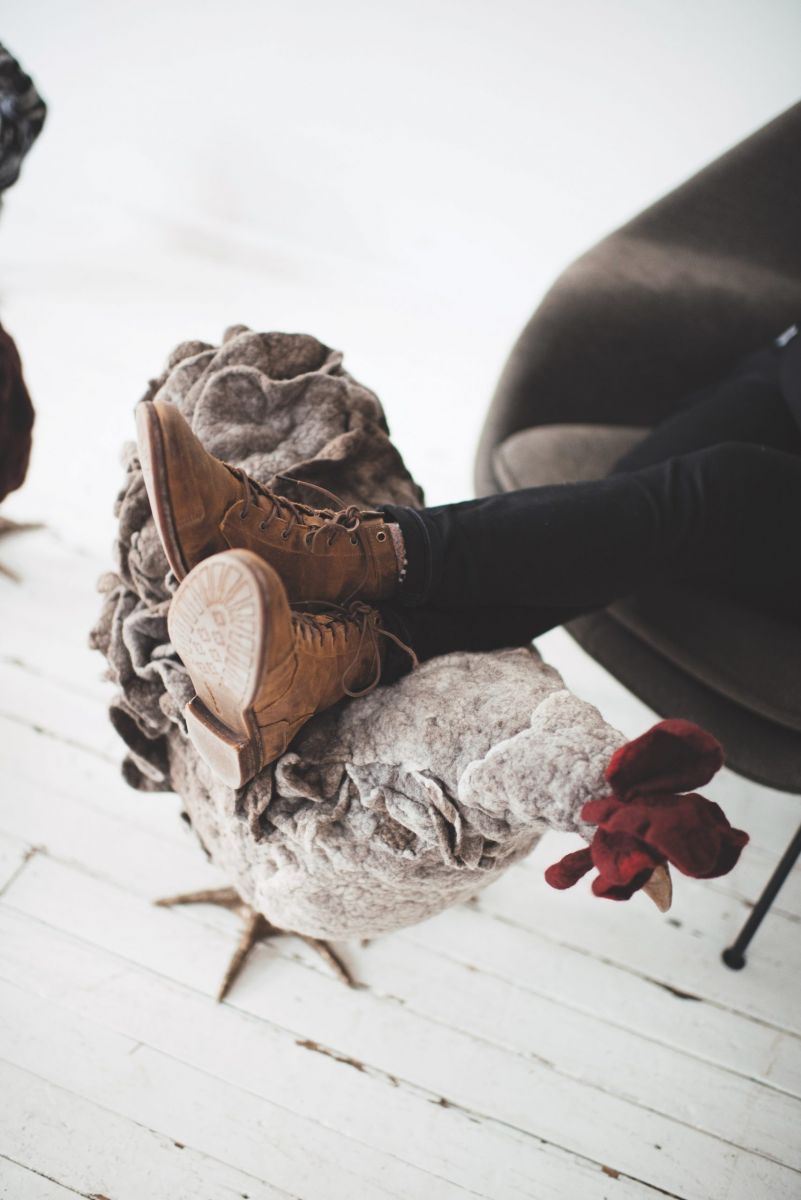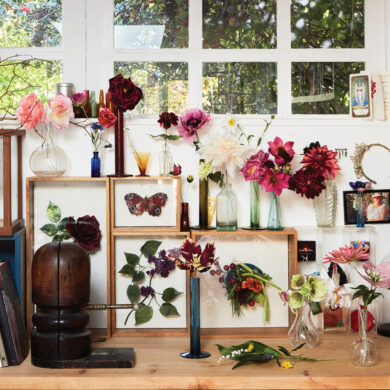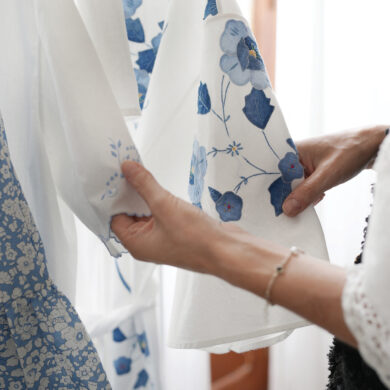I remember my first flock—of real chickens, that is—like it was yesterday. I grew up on a farm in Kansas and on my 12th birthday my parents decided to adopt a flock of pet chicks for me. As I watched them grow, I enjoyed hours of entertainment observing the chickens peck and scratch around the farm, full of personality, and beautiful in their own quirky ways.
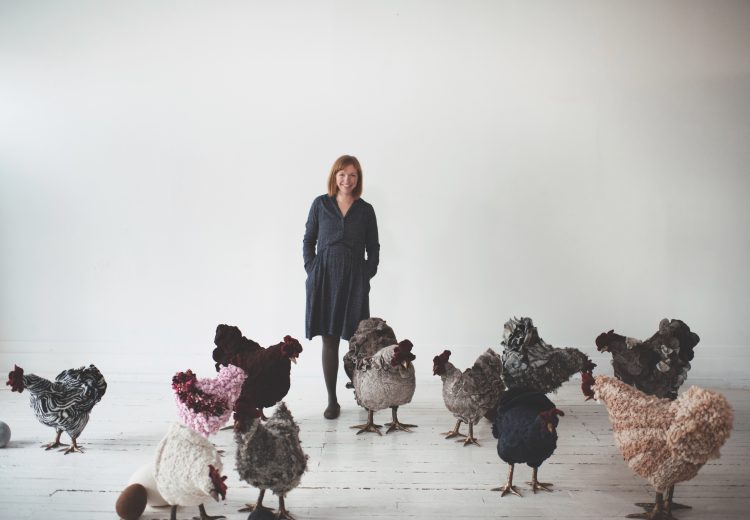
As much delight as I took in my pet chickens, I never would have guessed that they would become a strong creative influence in my life. Years later while I was working toward my Interior Architecture and Product Design degree at Kansas State University, I enrolled in a semester-long course in which we designed and built two small pieces of furniture. Inspired by the sheep ottomans sculpted by the artistic duo Claude and Francoise-Xavier Lalanne, I dreamed of creating my own sculptural piece, exploring similar materials but with a form that was personal to me. My mind looped back to my familiar childhood pets, my chickens. On the first day of class, when I approached my professor with the idea of making footstools shaped like chickens, his approving response was, “What is the essence of a chicken?” I think now about that moment with gratitude, as I half expected him to tell me that my idea wasn’t worth exploring. It’s a wonder that such a seemingly insignificant conversation would have a lasting impact on my life and career.
What is the essence of a chicken? In my studies, I determined that the expression of feet, posture, and combs were the most important elements in capturing their unique personalities. As I made prototypes, I embarked on a crash course in many skills—woodturning, bronze casting, and felting. It was important to me to work with natural, sustainable materials as pure and unprocessed as possible. Today, our footstools are still lovingly made using the same methods I learned in college. I named the original two chickens Henny and Penny.
Creating a Chicken Footstool
Each chicken footstool begins life as an egg—a wooden egg, that is. We work with a woodturner in Kansas who forages creek beds for naturally fallen logs. The harvested wood is then turned on a lathe to create a perfect egg shape—the heart of the chicken. The egg acts as an anchor for upholstery and a structurally sound center to help the chicken function as a footstool.
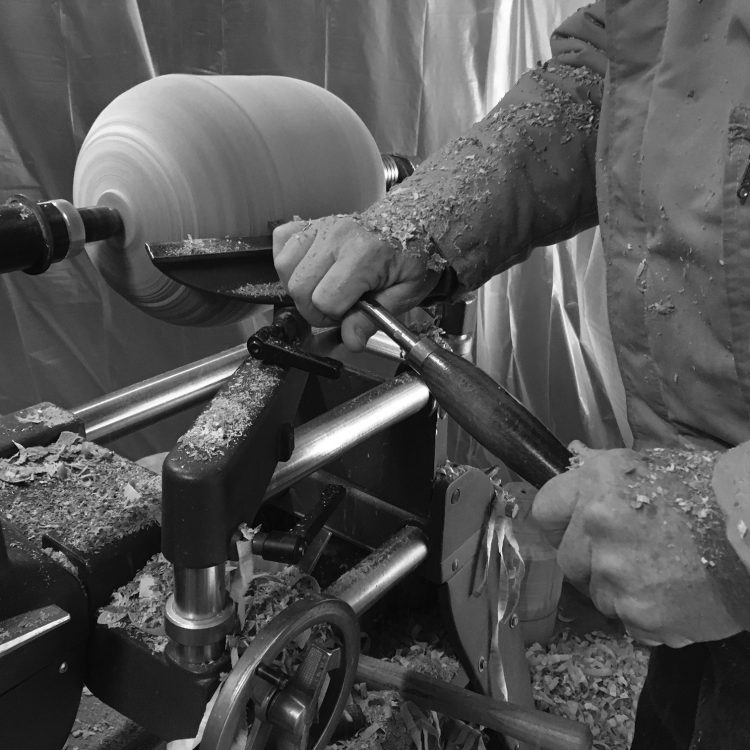
The chickens need sturdy legs and feet on which to stand. Through the design process, they were enlarged again and again in pursuit of a balanced footstool. Now the oversized bronze feet are one of the most defining features of a chicken made by The City Girl Farm. We work with a local foundry using a lost-wax casting method, where molten bronze is poured into a ceramic mold created from my original sculptures. When the bronze has cooled, the ceramic is chipped away to reveal the final piece. This same process is also used for the beak.
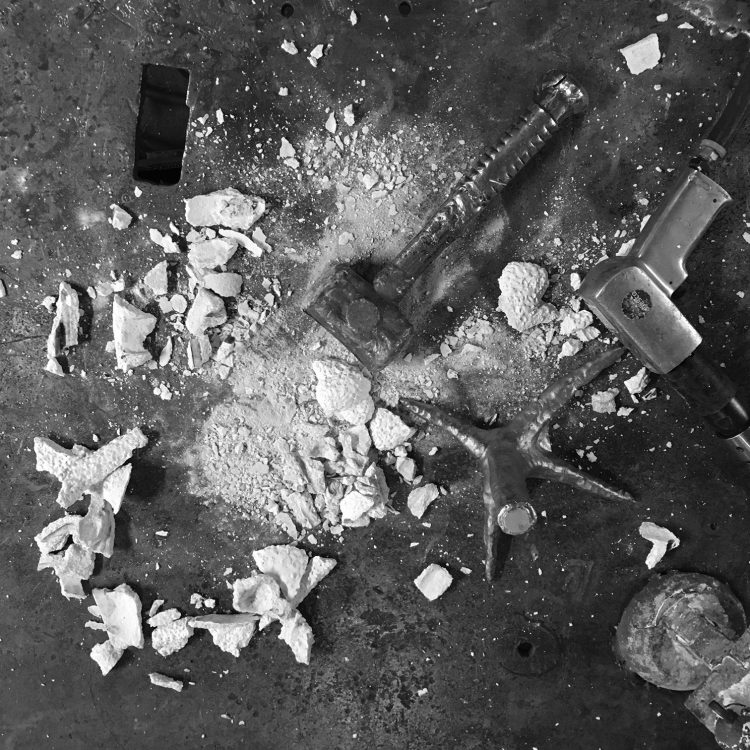
When the egg, legs, and beak are ready, they are transported to my hometown to one of my favorite production partners—my dad. He takes these components and builds them into what we call “naked chickens”. The legs are welded to a steel frame which is then attached to the wooden egg base. The bronze beak is connected to a spring to allow a subtle pecking action in the neck. This handbuilt process of the armature adds to the unique posture of each chicken.
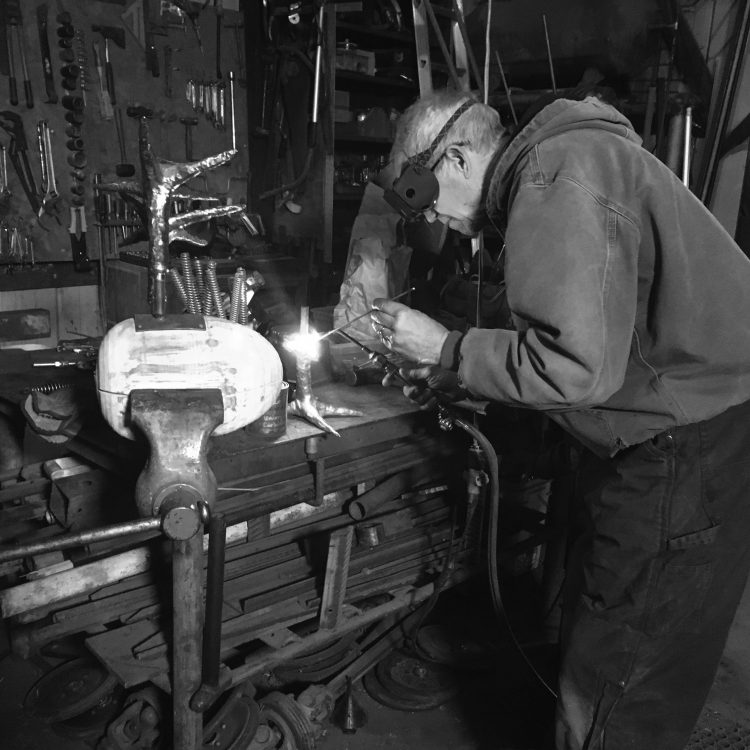
The naked chickens come home to roost in our studio where they are upholstered in burlap, foam, and muslin “underpants”.
Now the fun really begins with the creation of fiber “feathers”. We primarily work with Merino wool, sourced locally, domestically, and internationally from small farms and fiber mills where it is cleaned, lightly processed, and carded into roving or batts. Every footstool is fashioned with a unique batch of feathers created by our “chickeners” in and around Kansas City. These artisans work diligently and skillfully to upholster each chicken by hand, sculpting and stitching them one feather at a time. The creation processes— spinning, knitting, felting, and stitching—happen both at home and collaboratively at the studio. Each chicken is crowned with a signature red comb and is uniquely named and numbered. This entire process has become affectionately known as “The Art of Chickening”.
Our footstools are designed as furniture and are therefore larger than an actual chicken. We offer two sizes; the small version, known as Chicken Little Footstools, are approximately 14″ high and weigh around 12 pounds; the original size, known as Chicken Footstools, are approximately 18″ high and weigh around 25 pounds.
Chicken design inspiration may be found anywhere from the colors of a sunset to a collector’s request to coordinate with a custom, select fabric. Of course, we are always looking at real chickens for ideas—the colors and patterns found in nature can’t be bettered, but can certainly be playfully interpreted. As a studio, we are constantly experimenting with new methods of textile construction, pushing the boundaries of our own artistry. It seems like every idea, every experiment, gives birth to more design possibilities.
“There are always flowers for those who want to see them.” —Henri Matisse
Collections and Collaborations
Gee’s Bend collection
I believe that, like all art, the chickens can be used as a canvas to share stories and messages. In 2018, my design partner and I decided to create our first collection as an homage to one of our favorite designers and artists, Alexander Girard. It was an interesting challenge to design my art in the framework of someone else’s designs. When we debuted the collection at our local monthly art festival, the response was overwhelming. The collection truly reflected the bright and whimsical feeling of Girard’s work.
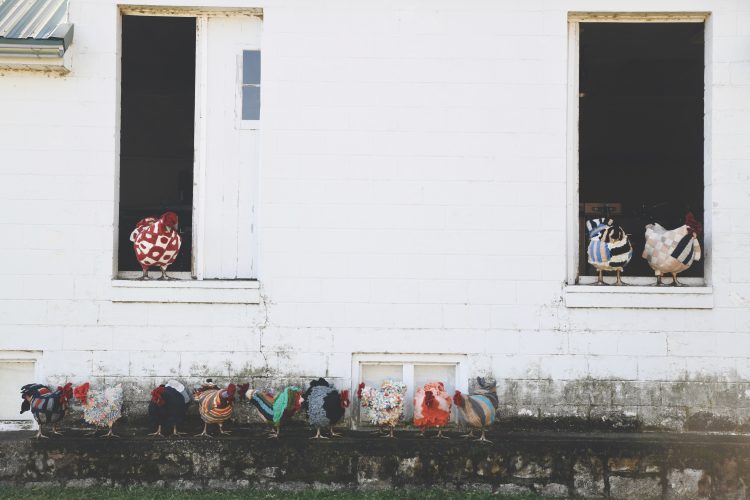
Our Gee’s Bend collection in 2020 featured 12 chickens that were inspired by 12 quilts created by the community of quiltmakers of Gee’s Bend, Alabama. While the contemporary graphic designs of the quilts are impressive, the truest inspiration was found in looking deeper into the stories of the women who created them. As we introduced each new chicken, we also shared its story—the artist who made the chicken, the quilt that inspired them, and the artist who designed the quilt. It was beautiful to bring the artist and inspiration full circle.
For years we have dreamed about working in collaboration with fiber artists perspectives. Recently, this became a reality when we invited a local fashion designer, Whitney Manney, to our work table and asked her, “How would you dress a chicken footstool?” Originally, we were going to make one big and one little chicken, but we enjoyed working with each other so much that it quickly grew to a nine-piece collection! Her neon colors and marbled fabric opened our eyes to many new design possibilities.
Chicken Community
As much as I cherish creating chickens, for me, my deepest joy is experienced through the way they allow me to connect with other people. In the early days, my mother, sister, and I were the three main “chickeners.” We had many adventures learning to work together — navigating art and trade shows in big cities, problem solving how to safely ship chickens world-wide, and experiencing the tremendous reactions of a growing audience.
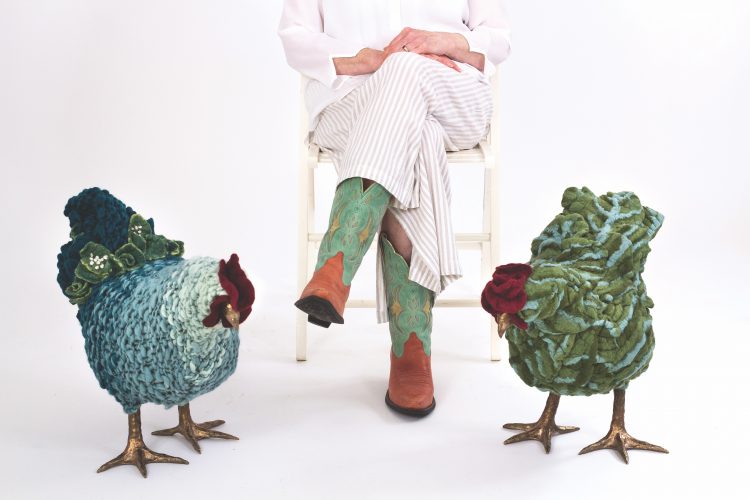
Eventually, I began inviting others into the chickening process. Each person who joined expanded the artistry and production capability of the studio, and now after ten years, a vibrant community has developed. The fiber artists, mostly women, employ their talent to make an income — all on their own schedules. The team encompasses a dynamic range of ages and backgrounds including several mothers and daughters, full-time moms that knit after their children are in bed, women with corporate jobs who stitch on the weekends, and part-time artists who work in the studio. I have been blessed to raise my 4-year-old daughter in an environment surrounded by such a kind, creative community. In many ways, I have also received nurturance as I grow as an entrepreneur, wife, and mother.
“There is nothing in a caterpillar that tells you it’s going to be a butterfly.”
— R. Buckminster Fuller
Our community of collectors and select retailers also continues to develop. We enjoy a balance of creating inspired collections, fulfilling custom chicken requests, and collaborating with designers and architects on special projects. It is amazing to witness our creations finding homes with families all over the world! We are thankful for each “adoption”, and we hope the chickens are enjoyed for generations to come. Every chicken holds the imprints of its journey from fleece to footstool. The idea to create chicken footstools was a gift and I am grateful that it has blossomed into a fulfilling career, not only for me but for other artists in our community. As The City Girl Farm continues to evolve, I look forward to more collaborations, creativity, and of course, colorful chickens.
I remember my first flock—of real chickens, that is—like it was yesterday. I grew up on a farm in Kansas and on my 12th birthday my parents decided to adopt a flock of pet chicks for me. As I watched them grow, I enjoyed hours of entertainment observing the chickens peck and scratch around the farm, full of personality, and beautiful in their own quirky ways.

As much delight as I took in my pet chickens, I never would have guessed that they would become a strong creative influence in my life. Years later while I was working toward my Interior Architecture and Product Design degree at Kansas State University, I enrolled in a semester-long course in which we designed and built two small pieces of furniture. Inspired by the sheep ottomans sculpted by the artistic duo Claude and Francoise-Xavier Lalanne, I dreamed of creating my own sculptural piece, exploring similar materials but with a form that was personal to me. My mind looped back to my familiar childhood pets, my chickens. On the first day of class, when I approached my professor with the idea of making footstools shaped like chickens, his approving response was, “What is the essence of a chicken?” I think now about that moment with gratitude, as I half expected him to tell me that my idea wasn’t worth exploring. It’s a wonder that such a seemingly insignificant conversation would have a lasting impact on my life and career.
What is the essence of a chicken? In my studies, I determined that the expression of feet, posture, and combs were the most important elements in capturing their unique personalities. As I made prototypes, I embarked on a crash course in many skills—woodturning, bronze casting, and felting. It was important to me to work with natural, sustainable materials as pure and unprocessed as possible. Today, our footstools are still lovingly made using the same methods I learned in college. I named the original two chickens Henny and Penny.
Creating a Chicken Footstool
Each chicken footstool begins life as an egg—a wooden egg, that is. We work with a woodturner in Kansas who forages creek beds for naturally fallen logs. The harvested wood is then turned on a lathe to create a perfect egg shape—the heart of the chicken. The egg acts as an anchor for upholstery and a structurally sound center to help the chicken function as a footstool.

The chickens need sturdy legs and feet on which to stand. Through the design process, they were enlarged again and again in pursuit of a balanced footstool. Now the oversized bronze feet are one of the most defining features of a chicken made by The City Girl Farm. We work with a local foundry using a lost-wax casting method, where molten bronze is poured into a ceramic mold created from my original sculptures. When the bronze has cooled, the ceramic is chipped away to reveal the final piece. This same process is also used for the beak.

When the egg, legs, and beak are ready, they are transported to my hometown to one of my favorite production partners—my dad. He takes these components and builds them into what we call “naked chickens”. The legs are welded to a steel frame which is then attached to the wooden egg base. The bronze beak is connected to a spring to allow a subtle pecking action in the neck. This handbuilt process of the armature adds to the unique posture of each chicken.

The naked chickens come home to roost in our studio where they are upholstered in burlap, foam, and muslin “underpants”.
Now the fun really begins with the creation of fiber “feathers”. We primarily work with Merino wool, sourced locally, domestically, and internationally from small farms and fiber mills where it is cleaned, lightly processed, and carded into roving or batts. Every footstool is fashioned with a unique batch of feathers created by our “chickeners” in and around Kansas City. These artisans work diligently and skillfully to upholster each chicken by hand, sculpting and stitching them one feather at a time. The creation processes— spinning, knitting, felting, and stitching—happen both at home and collaboratively at the studio. Each chicken is crowned with a signature red comb and is uniquely named and numbered. This entire process has become affectionately known as “The Art of Chickening”.
Our footstools are designed as furniture and are therefore larger than an actual chicken. We offer two sizes; the small version, known as Chicken Little Footstools, are approximately 14″ high and weigh around 12 pounds; the original size, known as Chicken Footstools, are approximately 18″ high and weigh around 25 pounds.
Chicken design inspiration may be found anywhere from the colors of a sunset to a collector’s request to coordinate with a custom, select fabric. Of course, we are always looking at real chickens for ideas—the colors and patterns found in nature can’t be bettered, but can certainly be playfully interpreted. As a studio, we are constantly experimenting with new methods of textile construction, pushing the boundaries of our own artistry. It seems like every idea, every experiment, gives birth to more design possibilities.
“There are always flowers for those who want to see them.” —Henri Matisse
Collections and Collaborations
Gee’s Bend collection
I believe that, like all art, the chickens can be used as a canvas to share stories and messages. In 2018, my design partner and I decided to create our first collection as an homage to one of our favorite designers and artists, Alexander Girard. It was an interesting challenge to design my art in the framework of someone else’s designs. When we debuted the collection at our local monthly art festival, the response was overwhelming. The collection truly reflected the bright and whimsical feeling of Girard’s work.

Our Gee’s Bend collection in 2020 featured 12 chickens that were inspired by 12 quilts created by the community of quiltmakers of Gee’s Bend, Alabama. While the contemporary graphic designs of the quilts are impressive, the truest inspiration was found in looking deeper into the stories of the women who created them. As we introduced each new chicken, we also shared its story—the artist who made the chicken, the quilt that inspired them, and the artist who designed the quilt. It was beautiful to bring the artist and inspiration full circle.
For years we have dreamed about working in collaboration with fiber artists perspectives. Recently, this became a reality when we invited a local fashion designer, Whitney Manney, to our work table and asked her, “How would you dress a chicken footstool?” Originally, we were going to make one big and one little chicken, but we enjoyed working with each other so much that it quickly grew to a nine-piece collection! Her neon colors and marbled fabric opened our eyes to many new design possibilities.
Chicken Community
As much as I cherish creating chickens, for me, my deepest joy is experienced through the way they allow me to connect with other people. In the early days, my mother, sister, and I were the three main “chickeners.” We had many adventures learning to work together — navigating art and trade shows in big cities, problem solving how to safely ship chickens world-wide, and experiencing the tremendous reactions of a growing audience.

Eventually, I began inviting others into the chickening process. Each person who joined expanded the artistry and production capability of the studio, and now after ten years, a vibrant community has developed. The fiber artists, mostly women, employ their talent to make an income — all on their own schedules. The team encompasses a dynamic range of ages and backgrounds including several mothers and daughters, full-time moms that knit after their children are in bed, women with corporate jobs who stitch on the weekends, and part-time artists who work in the studio. I have been blessed to raise my 4-year-old daughter in an environment surrounded by such a kind, creative community. In many ways, I have also received nurturance as I grow as an entrepreneur, wife, and mother.
“There is nothing in a caterpillar that tells you it’s going to be a butterfly.”
— R. Buckminster Fuller
Our community of collectors and select retailers also continues to develop. We enjoy a balance of creating inspired collections, fulfilling custom chicken requests, and collaborating with designers and architects on special projects. It is amazing to witness our creations finding homes with families all over the world! We are thankful for each “adoption”, and we hope the chickens are enjoyed for generations to come. Every chicken holds the imprints of its journey from fleece to footstool. The idea to create chicken footstools was a gift and I am grateful that it has blossomed into a fulfilling career, not only for me but for other artists in our community. As The City Girl Farm continues to evolve, I look forward to more collaborations, creativity, and of course, colorful chickens.







